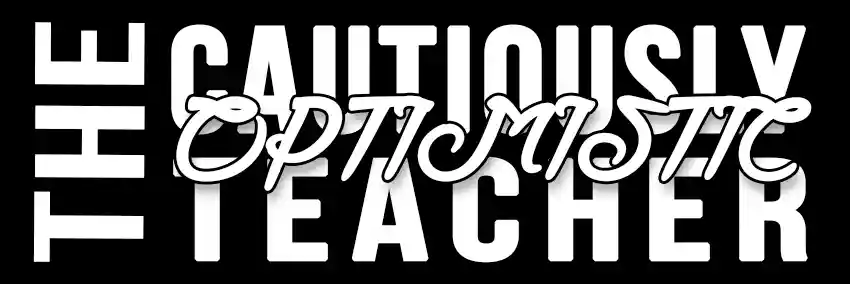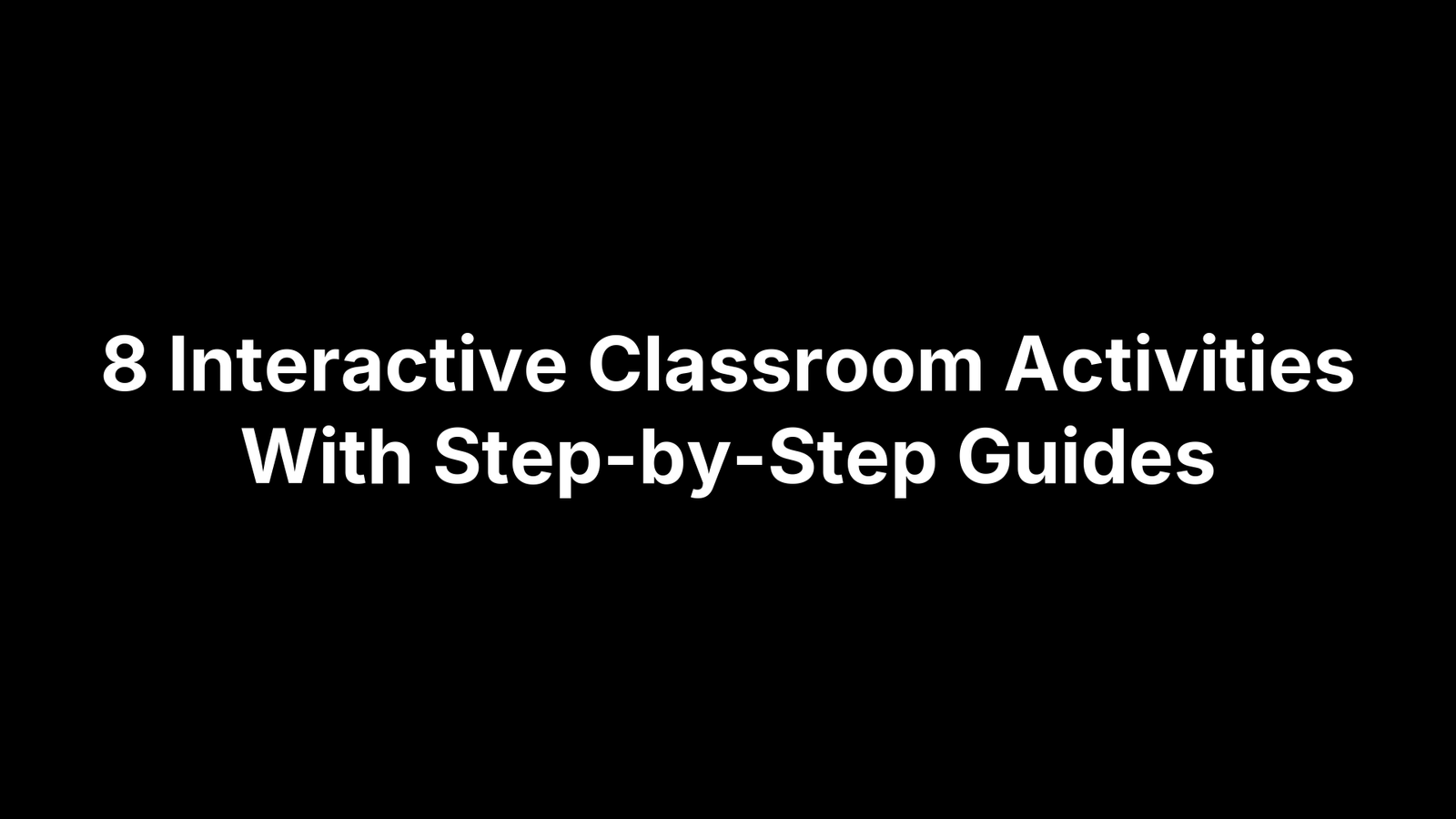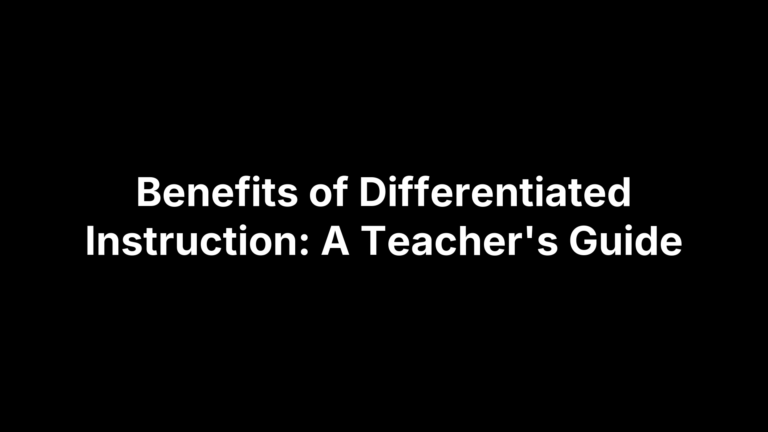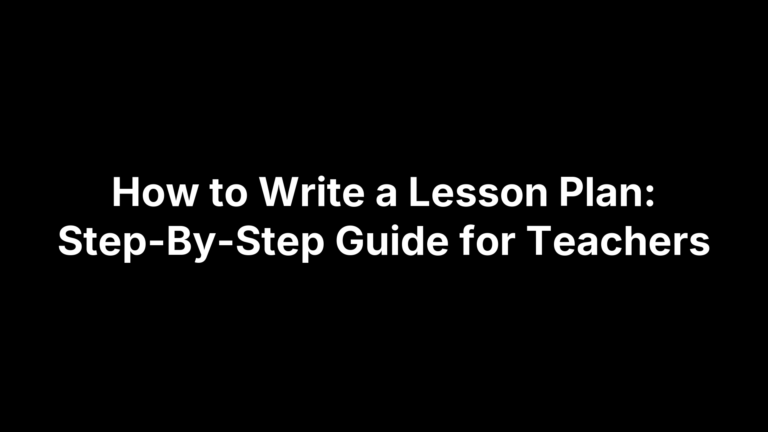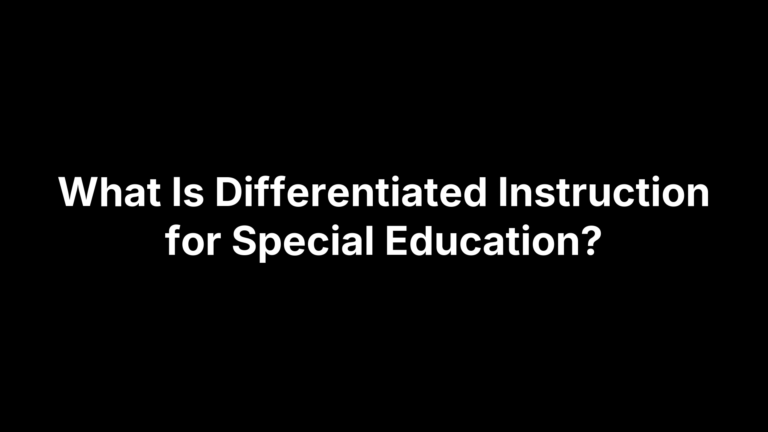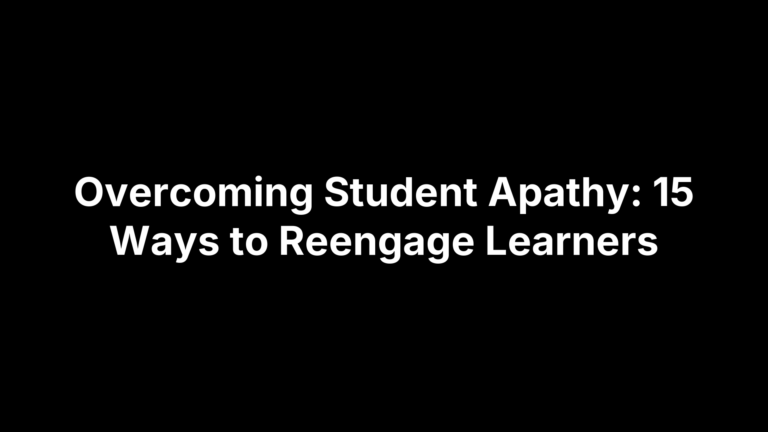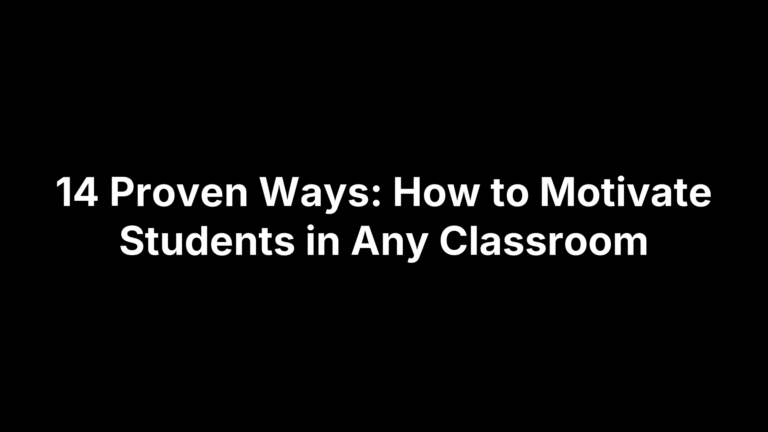8 Interactive Classroom Activities With Step-by-Step Guides
If you’ve ever posed a great question and met a wall of silence, watched group work drift off task, or felt participation shrink to the same few voices, you’re not alone. Time is tight, attention spans are shorter than your agenda, and “interactive” can’t mean chaos or an extra hour of prep. You need interactive classroom activities that actually boost learning, balance airtime, and include clear accountability—without reinventing your lesson or ignoring online/hybrid realities.
This guide gives you eight proven, ready-to-use routines with the structure busy teachers need. Each activity comes with: what you’ll need, step-by-step directions, timing and group size, assessment hooks, differentiation ideas, and a copyable template (including a free AI-powered choice board to jump-start planning). The moves here work across subjects and grades—from middle school through college—and translate smoothly to in-person or virtual spaces. Ready to get students moving, talking, and thinking with purpose? Start with the first routine and teach from the guide, not from memory.
1. Build a differentiated choice board with The Cautiously Optimistic Teacher’s AI tools (free template)
Choice boards turn one-size-fits-all lessons into student-driven journeys. With our AI tools, you can build a differentiated board in minutes, not hours—one of the most flexible interactive classroom activities for mixed-readiness classes or blended learning days.
What you’ll need
A few simple materials make this routine plug-and-play, whether you’re in person or online.
- Differentiated Instruction Helper: to generate tiered task ideas
- Worksheet Maker: to create quick supports (graphic organizers, checklists)
- Question Generator: to craft reflection prompts and exit slips
- A simple rubric or single-point rubric
- Slides or a printable grid, plus a timer
Step-by-step instructions
Keep the flow tight the first time; students learn the routine quickly.
- Define the goal: Name the standard/skill and success criteria in student-friendly language.
- Generate tasks: Use the Differentiated Instruction Helper to create 6–9 tasks at three levels (Support, Core, Extend).
- Attach supports: Use the Worksheet Maker to add organizers, word banks, or exemplars where needed.
- Set choice rules: Example: “Must pick 1 from each column” or “Complete any 3; at least one Extend.”
- Publish the board: Post the grid on slides/LMS; clarify time limits and turn-in expectations.
- Close with reflection: Use the Question Generator for a 2–3 item exit slip tied to the success criteria.
Assessment and accountability
Make choice feel safe and rigorous with light but visible checkpoints.
- Product + process: Collect the artifact and a 2–3 sentence reflection.
- Single-point rubric: One column of criteria; annotate strengths/next steps.
- Mid-block check-in: 60-second stand-up or quick thumbs meter.
- Exit slip: Two content questions + one metacognitive prompt.
Variations and differentiation
Use the board to honor readiness, interest, and learning preferences without creating extra prep.
- Readiness tiers: Label tasks “Support/Core/Extend;” allow “mix and match.”
- Mode choices: Offer options to write, record audio, sketch, or map.
- UDL nudges: Provide sentence starters, visuals, and exemplars proactively.
- Partner coach: Pair students as “doer/coach,” swapping halfway.
Timing and group size
This routine scales from a sprint to a full workshop block.
- Launch (5–7 min): Goal, criteria, choice rules.
- Work time (20–35 min): Solo, pairs, or trios.
- Share + exit (5–8 min): Quick showcase and reflection.
Template or example to copy
Use this 3×3 grid. Replace bracketed text with your unit focus and drop in supports as needed.
| Create (show understanding) | Analyze (dig deeper) | Apply (use it) | |
|---|---|---|---|
| Support | Write a 6–8 sentence summary of [topic] using the word bank. | Complete the guided organizer comparing [A] and [B]. | Find one real-world example of [concept] and explain it in 5 sentences. |
| Core | Record a 90-second audio explaining the big idea of [lesson]. | Annotate a short excerpt/image and label key evidence. | Design a step-by-step checklist to solve [problem type]. |
| Extend | Create a one-pager or infographic for peers on [concept]. | Draft a counterclaim and rebuttal to a common misconception. | Prototype a mini lesson (3 slides) to teach [skill] to a 6th grader. |
2. Think–pair–share 2.0: from quiet reflection to whole-class synthesis
This upgrade keeps the classic power of wait time and peer talk, then adds structures for equitable participation and visible thinking. It’s one of the simplest interactive classroom activities to run—now with a fast, whole-class synthesis that captures evidence of learning you can use right away.
What you’ll need
Keep materials lightweight so the routine is repeatable in any setting.
- A strong prompt tied to today’s success criteria
- Timer (visible to students)
- Note-catcher (paper or shared doc)
- Synthesis board (slide or whiteboard)
Step-by-step instructions
Establish the rhythm once; students will internalize it quickly.
- Think (1–2 min): Silent jot with sentence starters and evidence cues.
- Pair (2–3 min): A speaks, B paraphrases; then swap. Partners add one new idea.
- Square (2 min): Join another pair; agree on a best-supported claim.
- Share (3–5 min): Each group posts 1 claim + 1 evidence to the synthesis board.
- Synthesize (1–2 min): Class clusters similar ideas; teacher names patterns and next steps.
Assessment and accountability
Keep it light, visible, and aligned to the prompt.
- Pair note-catcher: “My idea,” “Partner’s idea,” “Consensus,” “Evidence.”
- Spot-checks: Listen to 3–4 pairs; stamp when paraphrase includes evidence.
- Exit slip: One-sentence claim using
because + evidence from ____.
Variations and differentiation
Small tweaks widen access without changing the flow.
- Pair–share–repeat: New partner round to spread high-quality ideas.
- Supports: Sentence stems, word banks, visual prompts for multilingual learners.
- Online: Breakout rooms + shared slide; use chat for the synthesis board.
Timing and group size
Works with any class size and most time blocks.
- Total: 10–14 minutes (1–2 think, 2–3 pair, 2 square, 3–5 share, 1–2 synth).
Template or example to copy
Use or paste this quick note-catcher; students complete it during the routine.
| Prompt | My idea | Partner’s idea | Our consensus claim | Evidence we used |
|---|---|---|---|---|
3. Four corners debate to get students moving and talking
When discussion stalls, a Four Corners debate adds motion, choice, and structure. Students commit to one of four responses, confer with peers, and surface evidence before sharing out. It’s a classic interactive classroom activity that builds energy without sacrificing purpose or classroom management.
What you’ll need
Keep setup simple so you can run this anytime.
- Four corner signs (A–D or labels for each response)
- A concise prompt with four distinct options
- Timer (visible)
- Chart paper or a shared slide for each corner
- Sentence stems for claims and evidence (optional)
Step-by-step instructions
Set clear expectations up front and let the structure do the work.
- Pose the prompt: Display the question with four response options.
- Reflect (1 min): Silent jot of initial choice + one reason.
- Move: Students go to their corner; quick headcount.
- Corner huddle (3–4 min): In pairs, share reasons; as a corner, craft one best-supported claim on your chart/slide.
- Cross-corner share (3–5 min): Each corner presents claim + 1–2 pieces of evidence; other corners paraphrase before responding.
- Switch or stand (1 min): Offer a chance to move corners if evidence changed minds; note the shift and why.
Assessment and accountability
Collect light evidence of thinking during and after the movement.
- Corner chart/slide: One claim + evidence becomes an artifact.
- Spot-check paraphrase: Stamp pairs when they accurately restate another corner.
- Exit slip: “I chose __ because __. After hearing others, I now think __.”
Variations and differentiation
Small tweaks widen access and keep the routine fresh.
- Agree scale: Label corners “Strongly agree/Agree/Disagree/Strongly disagree.”
- Text-dependent: Require one quote/data point per corner claim.
- Online: Use a poll with four options; send students to labeled breakout rooms.
- Language supports: Provide word banks, frames, or images tied to each option.
Timing and group size
This scales from a warm-up to a full-class debate.
- Total: 10–15 minutes (extend to 20 with rebuttals).
- Group size: Works from 12–35+; split crowded corners if needed.
- Space: Clear pathways; designate corners visibly.
Template or example to copy
Post your prompt with four clear responses students can choose among.
| Prompt: Which factor most drove the outcome of [event/concept]? | Corner A | Corner B | Corner C | Corner D |
|---|---|---|---|---|
| Choose and prepare evidence. | Leadership decisions | Economic pressures | Technology/innovation | Public sentiment |
4. Jigsaw expert groups to turn learners into teachers
The jigsaw turns content coverage into peer teaching: students first become “experts” on one slice of material, then teach it to their home group. It’s high-accountability collaboration that boosts comprehension and ownership—one of those interactive classroom activities that reliably engages quieter students and spreads talk time.
What you’ll need
- Segmented content: 3–5 short texts, clips, graphs, or problems
- Guiding questions: 2–3 per segment
- Visible roles and timer
- Note-catchers: Expert and home-group versions
- Labels: For expert groups (A–D) and home groups
Step-by-step instructions
- Form home groups (4–5): Assign roles A–D/E; distribute different segments.
- Expert round (5–8 min): All As meet, annotate, answer guiding questions, and draft 3 “must-teach” points; repeat for B/C/D groups.
- Teach-backs (10–15 min): Reassemble home groups; each expert teaches in 90–120 seconds using notes; peers capture key points/evidence.
- Check for understanding (2–4 min): Random “teach-back” where one student summarizes another’s segment or a 3-item quick quiz.
- Synthesize (2–3 min): Class names one-sentence takeaway per segment and a big-idea claim across all parts.
Assessment and accountability
- Artifacts: Collect expert notes + home-group note-catchers.
- Accuracy check: Stamp peers who paraphrase another segment correctly with evidence.
- Quick quiz: Three auto-gradable items (one per segment).
Variations and differentiation
- Multimodal jigsaw: Use short videos, data sets, images, or worked examples as segments.
- Supports: Vocabulary boxes, sentence stems, exemplar expert notes for multilingual learners.
- Online: Labeled breakout rooms for expert/home rounds; shared slide deck for notes.
Timing and group size
- Total: 20–35 minutes (expert 5–8, teach-backs 10–15, checks/synthesis 3–7).
- Grouping: Home groups of 4–5; expert groups by letter/role.
Template or example to copy
Use this planning grid to map segments and keep teach-backs tight.
| Segment | Guiding question(s) | Must-teach points (3) | Evidence/example to show |
|---|---|---|---|
| A | [How does X work?] | 1. [Point] 2. [Point] 3. [Point] | [Quote/data/image] |
| B | [Why did Y happen?] | 1. [Point] 2. [Point] 3. [Point] | [Quote/data/image] |
| C | [What’s the impact of Z?] | 1. [Point] 2. [Point] 3. [Point] | [Quote/data/image] |
| D | [How do A–C connect?] | 1. [Point] 2. [Point] 3. [Point] | [Quote/data/image] |
5. Gallery walk and graffiti boards for visible thinking
When ideas need to get out of heads and onto walls, combine a gallery walk with “graffiti boards.” Students rotate through stations, annotate peers’ thinking, and surface patterns—active, collaborative learning that makes thinking visible and keeps energy high. The Responsive Classroom “Graffiti” structure anchors this routine.
What you’ll need
Keep materials minimal so setup takes minutes, not prep periods.
- 4–6 station prompts on chart paper or slides posted around the room
- Markers or sticky notes (color-coded by group if possible)
- Timer (visible)
- Role cards (facilitator, scribe, evidence spotter, summarizer; optional)
Step-by-step instructions
Post clear norms: write anywhere on the chart, respond to ideas, and cite evidence when required.
- Set the stations (2 min): Post charts with different questions/ideas; include a “must-do.”
- Round 1 (3 min): Groups add claims, connections, or sketches directly on the chart—graffiti style.
- Rotate (3–4 rounds, 2–3 min each): At each new station, students first read what’s there, then add new thinking or respond with “I notice/I wonder.”
- Theme-finding (4–5 min): Return groups to one assigned station to circle or label emerging themes.
- Share-out (4–6 min): Each station gives a 30–45 second headline takeaway.
Assessment and accountability
Make contributions traceable and useful for next steps.
- Color code = accountability: Each group uses one color across stations.
- Station artifact: Snap photos or collect charts; these become study guides.
- Quick check: Stamp responses that include text/data evidence.
- Exit slip: “One pattern I saw was __ because __.”
Variations and differentiation
Adapt the flow to fit content, space, and learners.
- Silent conversation: No talking; only written responses.
- Text-dependent: Require one quote/data point per contribution.
- Digital gallery: Use a shared slide deck; each slide = station.
- Supports: Provide sentence stems, word banks, and visual prompts.
Timing and group size
This scales well for most rooms and class sizes.
- Total: 15–22 minutes (setup 2, rotations 8–12, theme 4–5, share 4–6).
- Groups: 3–4 students; 4–6 stations for classes of 20–32.
Template or example to copy
Post these at the top of each chart to focus contributions and evidence.
| Station | Prompt | Must do |
|---|---|---|
| 1 | Which claim best explains [topic]? | Write 1 claim + underline the evidence. |
| 2 | How do [A] and [B] compare? | Add a similarity and a difference; cite the text/data. |
| 3 | What pattern do you see across examples? | Circle 2 related notes and label the pattern. |
| 4 | What’s a common misconception here? | Write it, then rebut with evidence. |
6. Snowball statements for anonymous, high-energy sharing
When you need every voice without the fear factor, run a Snowball. Students write anonymous responses, crumple, toss, then pick and read a peer’s idea. It’s fast, low-prep, and, as in the Responsive Classroom “Snowball” structure, delivers big energy with safer participation.
What you’ll need
Keep it simple so you can launch in under a minute.
- Half-sheets or strips of paper (one per student)
- A focused prompt (claim, misconception check, or quick reflection)
- Timer (visible)
- “Target zone” to toss papers (bin, circle on floor)
- Sentence stems for claims/evidence (optional)
Step-by-step instructions
Preview norms: concise, school-appropriate, no names—ideas only.
- Write (1 min): Students respond to the prompt on paper; no names.
- Crumple (10 sec): Make a “snowball.”
- Toss (10 sec): All toss to the target zone together.
- Pick (10 sec): Everyone grabs a new snowball.
- Read + mark (2–3 min): Silent read; underline the claim and box evidence (if present).
- Share (3–5 min): In a circle or rows, students read aloud; teacher or a student recorder tallies themes on the board.
Assessment and accountability
Honor anonymity while collecting evidence of thinking.
- Theme tally: Cluster repeated claims; note how many included evidence.
- Quick write:
I heard... so now I think... because (evidence from __). - Artifact check: Sort a sample into “claim only/claim + evidence” to guide feedback.
Variations and differentiation
Small shifts tailor the routine to purpose and learners.
- Agree/Disagree/Depends: Students add A/D/Dep at the end; tally shifts.
- Text-dependent: Require a quote/data point; provide stems and word banks.
- Pair echo: After reading, pairs paraphrase and add one strengthening detail.
- Online: Use an anonymous form; randomly assign responses for students to read on a shared slide.
Timing and group size
Snowball fits almost any class and room layout.
- Total: 7–12 minutes (write 1, toss/pick 0.5, read 2–3, share 3–7).
- Group size: 10–35+; split large classes into two circles if needed.
- Space: Clear a center “toss zone” for safety.
Template or example to copy
Post a tight prompt and give students a concise response frame to boost quality.
| Prompt | Response stem | Evidence cue |
|---|---|---|
| “Which factor most influenced [topic/event]?” | “The most important factor was __ because __.” | “Evidence from [text/data]: ‘__’ (line/page/figure __).” |
7. Concentric circles (academic speed dating) for rapid peer dialogue
When you need fast, equitable talk time, Concentric Circles delivers. Students face a partner, discuss a focused prompt, then one circle rotates to form new pairs. It’s kinetic, structured, and perfect for spiraling content or previewing a text—an easy add to your interactive classroom activities toolkit.
What you’ll need
Keep materials lean so you can launch on the fly.
- Open-ended prompts aligned to today’s goal
- Timer visible to all
- Space for two circles or two straight “speed lines”
- Discussion stems and vocabulary supports (optional)
- Mini note-catcher for quick jotting (optional)
Step-by-step instructions
Model one round, then let the routine run itself.
- Form circles: Half the class stands in an inner circle facing out; the rest form an outer circle facing in.
- Prompt (projected): Post one question or claim that invites evidence-based responses.
- Discuss (2–3 min): Partner A speaks for 45–60 seconds; Partner B paraphrases and adds on; then swap.
- Rotate (10–15 sec): Outer circle moves one person to the right; inner circle stays.
- Repeat (3–5 rounds): New prompt each round or build on the previous one.
- Synthesize (2–3 min): Whole-class debrief: “Best idea you heard—not your own—and the evidence behind it.”
Assessment and accountability
Make listening and evidence visible without slowing the pace.
- Paraphrase check: Randomly call on students to restate a partner’s claim with evidence.
- Stamp walk: Circulate; stamp note-catchers that include
claim + because + evidence. - Micro-exit:
One insight I borrowed was __ because __ (from __).
Variations and differentiation
Tight shifts keep the routine accessible and fresh.
- Speed lines: Two rows facing each other if space is tight.
- Triads: One “listener–coach” joins pairs if numbers are uneven.
- Agree/Disagree round: Partners take opposite stances using stems.
- Text/data round: Display a short quote/figure; require one cited reference.
- Supports: Provide stems, word banks, and visual prompts for multilingual learners.
Timing and group size
Plan the arc before you start so you can land it cleanly.
- Total: 12–18 minutes (4 rounds at 2–3 min + rotation + 2–3 min synth)
- Group size: Up to 20 students works best; split larger classes into two circles.
Template or example to copy
Project or print this quick tracker; students jot one line between rotations.
| Round | Prompt | Best idea I heard (not mine) | Evidence/Example cited |
|---|---|---|---|
| 1 | [Claim about today’s topic] | ||
| 2 | [Counterclaim or application] | ||
| 3 | [Compare/contrast A vs. B] | ||
| 4 | [So what?/Implication] |
8. Socratic seminar with evidence trackers for deeper discourse
When you want students to move beyond opinions and into claims anchored in text or data, run a Socratic seminar. Students prepare, pose higher-order questions, and sustain a peer-led discussion where every contribution is backed by evidence—an essential move in your interactive classroom activities playbook.
What you’ll need
Keep the tools simple so cognitive load stays on the text and talk.
- Anchor text(s)/artifact(s): reading, primary source, data set, image, or clip
- Open-ended launch prompt tied to your success criteria
- Evidence tracker (paper or shared doc)
- Discussion norms and sentence stems posted
- Visible timer and a whiteboard/slide for themes
Step-by-step instructions
Model citing evidence once; then let students do the heavy lifting.
- Prep (before class): Students annotate the text/artifact and bring 2 questions + 2–3 cited pieces of evidence.
- Set norms (2 min): One voice at a time, build on ideas, disagree respectfully, and cite evidence every time.
- Warm-up (1 min): Quick write: a tentative claim to the launch prompt.
- Seminar (12–15 min): Students lead. Teacher only probes with “Where do you see that?” and “Who can build or challenge with evidence?”
- Mid-pause (1 min): Silent jot: strongest evidence heard so far and why.
- Final round (3 min): Each student shares “My most persuasive evidence is… because…”
- Synthesize (2–3 min): Class names patterns, tensions, and a next-step question.
Assessment and accountability
Light-touch systems keep quality high without stealing airtime.
- Evidence tracker collection: Credit for
claim + source line/figure + warrant. - Paraphrase spot-checks: Random students restate a peer’s claim with the cited evidence.
- Contribution goals: Students self-tally two evidence-based contributions.
- Exit slip: “The evidence that shifted my thinking was __ because __.”
Variations and differentiation
Tailor the structure to fit content, access, and space.
- Fishbowl: Half the class discusses while the outer circle tracks evidence; then switch.
- Data seminar: Use charts, graphs, or images as the “text;” require figure references.
- Online: Breakout room seminars + shared evidence tracker; whole-class synthesis at the end.
- Supports: Sentence stems, vocabulary banks, and pre-highlighted excerpts for multilingual learners.
Timing and group size
Plan the arc so talk time is equitable and purposeful.
- Total: 18–25 minutes (norms 2, warm-up 1, seminar 12–15, close 3–5).
- Group size: Works best with ~20 students; with more, run two rounds or use fishbowl.
Template or example to copy
Project or print this tracker so students capture evidence and practice warrants.
| Speaker | Claim (concise) | Evidence (quote/data + line/figure) | How the evidence supports the claim (warrant) | Build/Challenge note |
|---|---|---|---|---|
Talk stems to post:
- “I agree/disagree with ___ because the text shows ‘__’ (p. __).”
- “To build on ___’s point, another piece of evidence is __ (fig. __), which suggests __.”
- “A counterexample is __; how does that fit with our claim?”
Bring it to your classroom
You don’t need a cart of supplies to make learning active—just a plan you can run on repeat. Pick two routines from this guide, print or post one template each, set a visible timer, and close with a quick evidence check. That’s enough to rebalance airtime, raise cognitive load, and keep momentum without adding prep. If you want ready-to-copy boards, rubrics, question stems, and the free tools referenced here, explore The Cautiously Optimistic Teacher. Bookmark this guide, choose your “daily drivers,” and try them twice this week. Teach the routine once; let it do the work every time after.
